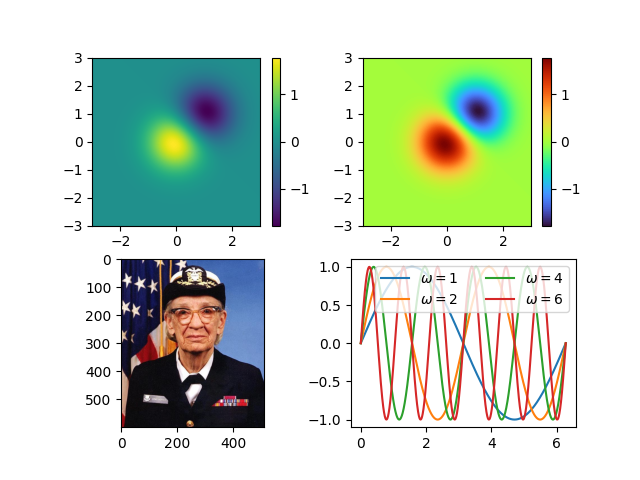Note
Click here to download the full example code
mplcvd -- an example of figure hook#
To use this hook, ensure that this module is in your PYTHONPATH, and set
rcParams["figure.hooks"] = ["mplcvd:setup"]. This hook depends on
the colorspacious third-party module.

import functools
from pathlib import Path
import colorspacious
import numpy as np
_BUTTON_NAME = "Filter"
_BUTTON_HELP = "Simulate color vision deficiencies"
_MENU_ENTRIES = {
"None": None,
"Greyscale": "greyscale",
"Deuteranopia": "deuteranomaly",
"Protanopia": "protanomaly",
"Tritanopia": "tritanomaly",
}
def _get_color_filter(name):
"""
Given a color filter name, create a color filter function.
Parameters
----------
name : str
The color filter name, one of the following:
- ``"none"``: ...
- ``"greyscale"``: Convert the input to luminosity.
- ``"deuteranopia"``: Simulate the most common form of red-green
colorblindness.
- ``"protanopia"``: Simulate a rarer form of red-green colorblindness.
- ``"tritanopia"``: Simulate the rare form of blue-yellow
colorblindness.
Color conversions use `colorspacious`_.
Returns
-------
callable
A color filter function that has the form:
def filter(input: np.ndarray[M, N, D])-> np.ndarray[M, N, D]
where (M, N) are the image dimensions, and D is the color depth (3 for
RGB, 4 for RGBA). Alpha is passed through unchanged and otherwise
ignored.
"""
if name not in _MENU_ENTRIES:
raise ValueError(f"Unsupported filter name: {name!r}")
name = _MENU_ENTRIES[name]
if name is None:
return None
elif name == "greyscale":
rgb_to_jch = colorspacious.cspace_converter("sRGB1", "JCh")
jch_to_rgb = colorspacious.cspace_converter("JCh", "sRGB1")
def convert(im):
greyscale_JCh = rgb_to_jch(im)
greyscale_JCh[..., 1] = 0
im = jch_to_rgb(greyscale_JCh)
return im
else:
cvd_space = {"name": "sRGB1+CVD", "cvd_type": name, "severity": 100}
convert = colorspacious.cspace_converter(cvd_space, "sRGB1")
def filter_func(im, dpi):
alpha = None
if im.shape[-1] == 4:
im, alpha = im[..., :3], im[..., 3]
im = convert(im)
if alpha is not None:
im = np.dstack((im, alpha))
return np.clip(im, 0, 1), 0, 0
return filter_func
def _set_menu_entry(tb, name):
tb.canvas.figure.set_agg_filter(_get_color_filter(name))
tb.canvas.draw_idle()
def setup(figure):
tb = figure.canvas.toolbar
if tb is None:
return
for cls in type(tb).__mro__:
pkg = cls.__module__.split(".")[0]
if pkg != "matplotlib":
break
if pkg == "gi":
_setup_gtk(tb)
elif pkg in ("PyQt5", "PySide2", "PyQt6", "PySide6"):
_setup_qt(tb)
elif pkg == "tkinter":
_setup_tk(tb)
elif pkg == "wx":
_setup_wx(tb)
else:
raise NotImplementedError("The current backend is not supported")
def _setup_gtk(tb):
from gi.repository import Gio, GLib, Gtk
for idx in range(tb.get_n_items()):
children = tb.get_nth_item(idx).get_children()
if children and isinstance(children[0], Gtk.Label):
break
toolitem = Gtk.SeparatorToolItem()
tb.insert(toolitem, idx)
image = Gtk.Image.new_from_gicon(
Gio.Icon.new_for_string(
str(Path(__file__).parent / "images/eye-symbolic.svg")),
Gtk.IconSize.LARGE_TOOLBAR)
# The type of menu is progressively downgraded depending on GTK version.
if Gtk.check_version(3, 6, 0) is None:
group = Gio.SimpleActionGroup.new()
action = Gio.SimpleAction.new_stateful("cvdsim",
GLib.VariantType("s"),
GLib.Variant("s", "none"))
group.add_action(action)
@functools.partial(action.connect, "activate")
def set_filter(action, parameter):
_set_menu_entry(tb, parameter.get_string())
action.set_state(parameter)
menu = Gio.Menu()
for name in _MENU_ENTRIES:
menu.append(name, f"local.cvdsim::{name}")
button = Gtk.MenuButton.new()
button.remove(button.get_children()[0])
button.add(image)
button.insert_action_group("local", group)
button.set_menu_model(menu)
button.get_style_context().add_class("flat")
item = Gtk.ToolItem()
item.add(button)
tb.insert(item, idx + 1)
else:
menu = Gtk.Menu()
group = []
for name in _MENU_ENTRIES:
item = Gtk.RadioMenuItem.new_with_label(group, name)
item.set_active(name == "None")
item.connect(
"activate", lambda item: _set_menu_entry(tb, item.get_label()))
group.append(item)
menu.append(item)
menu.show_all()
tbutton = Gtk.MenuToolButton.new(image, _BUTTON_NAME)
tbutton.set_menu(menu)
tb.insert(tbutton, idx + 1)
tb.show_all()
def _setup_qt(tb):
from matplotlib.backends.qt_compat import QtGui, QtWidgets
menu = QtWidgets.QMenu()
try:
QActionGroup = QtGui.QActionGroup # Qt6
except AttributeError:
QActionGroup = QtWidgets.QActionGroup # Qt5
group = QActionGroup(menu)
group.triggered.connect(lambda action: _set_menu_entry(tb, action.text()))
for name in _MENU_ENTRIES:
action = menu.addAction(name)
action.setCheckable(True)
action.setActionGroup(group)
action.setChecked(name == "None")
actions = tb.actions()
before = next(
(action for action in actions
if isinstance(tb.widgetForAction(action), QtWidgets.QLabel)), None)
tb.insertSeparator(before)
button = QtWidgets.QToolButton()
# FIXME: _icon needs public API.
button.setIcon(tb._icon(str(Path(__file__).parent / "images/eye.png")))
button.setText(_BUTTON_NAME)
button.setToolTip(_BUTTON_HELP)
button.setPopupMode(QtWidgets.QToolButton.ToolButtonPopupMode.InstantPopup)
button.setMenu(menu)
tb.insertWidget(before, button)
def _setup_tk(tb):
import tkinter as tk
tb._Spacer() # FIXME: _Spacer needs public API.
button = tk.Menubutton(master=tb, relief="raised")
button._image_file = str(Path(__file__).parent / "images/eye.png")
# FIXME: _set_image_for_button needs public API (perhaps like _icon).
tb._set_image_for_button(button)
button.pack(side=tk.LEFT)
menu = tk.Menu(master=button, tearoff=False)
for name in _MENU_ENTRIES:
menu.add("radiobutton", label=name,
command=lambda _name=name: _set_menu_entry(tb, _name))
menu.invoke(0)
button.config(menu=menu)
def _setup_wx(tb):
import wx
idx = next(idx for idx in range(tb.ToolsCount)
if tb.GetToolByPos(idx).IsStretchableSpace())
tb.InsertSeparator(idx)
tool = tb.InsertTool(
idx + 1, -1, _BUTTON_NAME,
# FIXME: _icon needs public API.
tb._icon(str(Path(__file__).parent / "images/eye.png")),
# FIXME: ITEM_DROPDOWN is not supported on macOS.
kind=wx.ITEM_DROPDOWN, shortHelp=_BUTTON_HELP)
menu = wx.Menu()
for name in _MENU_ENTRIES:
item = menu.AppendRadioItem(-1, name)
menu.Bind(
wx.EVT_MENU,
lambda event, _name=name: _set_menu_entry(tb, _name),
id=item.Id,
)
tb.SetDropdownMenu(tool.Id, menu)
if __name__ == '__main__':
import matplotlib.pyplot as plt
from matplotlib import cbook
plt.rcParams['figure.hooks'].append('mplcvd:setup')
fig, axd = plt.subplot_mosaic(
[
['viridis', 'turbo'],
['photo', 'lines']
]
)
delta = 0.025
x = y = np.arange(-3.0, 3.0, delta)
X, Y = np.meshgrid(x, y)
Z1 = np.exp(-X**2 - Y**2)
Z2 = np.exp(-(X - 1)**2 - (Y - 1)**2)
Z = (Z1 - Z2) * 2
imv = axd['viridis'].imshow(
Z, interpolation='bilinear',
origin='lower', extent=[-3, 3, -3, 3],
vmax=abs(Z).max(), vmin=-abs(Z).max()
)
fig.colorbar(imv)
imt = axd['turbo'].imshow(
Z, interpolation='bilinear', cmap='turbo',
origin='lower', extent=[-3, 3, -3, 3],
vmax=abs(Z).max(), vmin=-abs(Z).max()
)
fig.colorbar(imt)
# A sample image
with cbook.get_sample_data('grace_hopper.jpg') as image_file:
photo = plt.imread(image_file)
axd['photo'].imshow(photo)
th = np.linspace(0, 2*np.pi, 1024)
for j in [1, 2, 4, 6]:
axd['lines'].plot(th, np.sin(th * j), label=f'$\\omega={j}$')
axd['lines'].legend(ncols=2, loc='upper right')
plt.show()